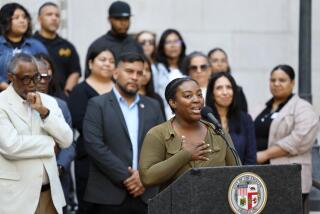Government Programs to Help the Poor Begin to Save
- Share via
PIKEVILLE, Ky. — Geneva Thacker’s wish sounds simple enough. She’d like city water hooked up to her trailer so she and her two young children don’t have to carry it anymore.
“I pack it in buckets from Mommy’s,” said the 29-year-old eastern Kentucky woman, who washes clothes by hand and uses a barrel to catch rainwater. “It’s a big hill. That’d mean everything to me to get to put my bathroom in and my water.
“I’d probably think I was rich.”
But all that--the water lines, meter and septic system--would cost about $2,500. And like most welfare recipients, the Booneville resident doesn’t have much money to spare at the end of each month.
Until recently, government regulations actually discouraged recipients from saving by cutting off benefits when bank accounts got even a little money in them.
But thanks, in part, to welfare reform, Thacker and others in her remote community may soon be able to parlay a $15-a-month investment into enough money to start a business, get an education, or finance or repair a house.
They would do it through individual development accounts, or IDAs. The program uses private or public matching dollars to give the poor the incentive--and the means--to save.
In Thacker’s case, for every dollar she saves, $6 in grant money will be added to her account. But this is no handout, says the man who developed the concept.
“We spend over $200 billion a year in the United States in federal tax exemptions for asset accumulation in home mortgages and retirement pension accounts, and these are the vehicles through which most middle-class individuals accumulate some assets,” said Michael Sherraden, director of the Center for Social Development at Washington University in St. Louis.
“So the principle of government supporting asset accumulation is already well established. It’s just that we haven’t done it for poor people.”
The IDA concept has been around since the late 1980s. But the idea is just starting to pick up steam as a way to help people become self-sufficient.
Recently enacted federal welfare reforms allow states to lift asset limits on welfare recipients. States also may use part of their federal welfare block grants to match IDA deposits.
Iowa, a leader in welfare reform, was the first state to do it, matching 20 cents on the dollar, Sherraden said. He said about a dozen states have either enacted or are considering such legislation.
Private organizations have been testing the waters for several years.
The Women’s Self-Employment Project in Chicago is in the second year of a two-year demonstration with 50 low-income women. Using $60,000 in city money as leverage with the Harris Bank, the organization has been able to give a 2-to-1 match on monthly deposits, president Connie Evans said.
In Indianapolis, Eastside Community Investments Inc. is using grant money to match IDA deposits by a ratio of up to 9-to-1. The program has allowed Shanise Manyfield-Russell to emerge from a battered-spouse shelter with hopes of running her own day care center.
Manyfield-Russell, 32, who is raising children ages 4, 5, 6 and 7 by herself, deposited $75 in the account last August and now has more than $1,000. She is using the money to go back to school and get certified in early childhood development.
“Without this program, I would never have been able to take a chance on finding what I really would like to do,” said Manyfield-Russell, who already keeps up to 10 children a day during the summer.
Thacker, who dropped out of school in the 11th grade and has been on welfare for about nine years, earns her $328 monthly benefits in a nonprofit T-shirt and used clothing shop. She said it’s hard to save $15 a month, but the program will give her a sense of accomplishment.
Sherraden said there are now about 40 IDA programs nationwide, and the concept is spreading.
More to Read
Inside the business of entertainment
The Wide Shot brings you news, analysis and insights on everything from streaming wars to production — and what it all means for the future.
You may occasionally receive promotional content from the Los Angeles Times.










